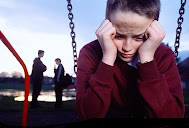"According to the teacher, my child with Autism [level 1] tends to have a difficult time moving from one activity to the next (for example, from writing skills to Math problems to recreation time). Do you have any suggestions as to how his teacher can make these transitions less stressful for him?"
 Transitions are very difficult for children with ASD. It is an interruption to their day and a change in their schedule. In order to minimize difficulty in transition, try to keep their schedule as routine as possible (e.g., doing 'writing' exercises first, solving 'Math' problems second, and 'reading' third ...in this order every time). And always let you son know ahead of time that a transition in routine is coming.
Transitions are very difficult for children with ASD. It is an interruption to their day and a change in their schedule. In order to minimize difficulty in transition, try to keep their schedule as routine as possible (e.g., doing 'writing' exercises first, solving 'Math' problems second, and 'reading' third ...in this order every time). And always let you son know ahead of time that a transition in routine is coming.
Using sensory integration techniques can be very helpful for some autistic children. It is best to have an occupational therapist work with you to first determine if your child is hyper-sensitive or hypo-sensitive. For example, does he crave movement and the feeling of different textures and stimulation, or does he avoid movement and textures.
Here is a summary of a case study:
A young student with ASD level 1 had a great deal of difficulty with the transition from home to school, and with transitions that occurred in his school day. The school created a sensory room that was just his. He craved movement, running and jumping on furniture, loved to feel smooth surfaces, and loved strong odors (in other words, he was hypo-sensitive).
In his sensory room, there was a large hammock for him to lie in that would hold him tight and swing. The ceiling was lined with colored lights. There were boxes with potpourri for him to smell.
He would spend 10 minutes in this room at the beginning of his school day, 10 minutes before lunch, and 10 minutes before returning home. While he was in the room, he was encouraged to take in as much sensory information as he could.
Once he left the room, he was calm and ready to learn. Prior to the intervention of the sensory room, the school was ready to expel him. With the sensory room in place, he became much more compliant, calm, and willing to work with teachers and peers.
This won’t work for every child, but demonstrates how some creative thinking can benefit even the most challenging behaviors. The important thing is to remember what works for your child, and incorporate that into his daily routine.
The scenario above is just one of dozens of examples of accommodations that schools can make if they are willing to put forth a little extra effort.
Resources for parents of children and teens on the autism spectrum:
==> How to Prevent Meltdowns and Tantrums in Children with Autism Spectrum Disorder
==> Parenting System that Reduces Defiant Behavior in Teens with Autism Spectrum Disorder
==> Launching Adult Children with Autism Spectrum Disorder: Guide for Parents Who Want to Promote Self-Reliance
==> Teaching Social-Skills and Emotion-Management to Children with Autism Spectrum Disorder
==> Parenting Children and Teens with High-Functioning Autism: Parents' Comprehensive Handbook
==> Unraveling the Mystery Behind High-Functioning Autism: Audio Book
==> Crucial Research-Based Parenting Strategies for Children and Teens with High-Functioning Autism
==> Parenting System that Reduces Defiant Behavior in Teens with Autism Spectrum Disorder
==> Launching Adult Children with Autism Spectrum Disorder: Guide for Parents Who Want to Promote Self-Reliance
==> Teaching Social-Skills and Emotion-Management to Children with Autism Spectrum Disorder
==> Parenting Children and Teens with High-Functioning Autism: Parents' Comprehensive Handbook
==> Unraveling the Mystery Behind High-Functioning Autism: Audio Book
==> Crucial Research-Based Parenting Strategies for Children and Teens with High-Functioning Autism
PARENTS' COMMENTS:
• Anonymous said... a first then card on his desk with Velcro pictures, first is the current task and then is the task they are switching to - not just subjects but include snack, lunch, packing up back pack, etc on pictures, as the current one is finished more the then to first and put the new then on. Does not have to think about the whole day, just what is happening now and what will happen next - then reminders from teacher about how long until next task is great, so something along the lines of 5 more min of math then we will be doing literacy, then again at 2 minutes if 2 reminders not enough, then maybe 3
• Anonymous said... A part of my daughters IEP is to give warning to finish her thought or assignment to them move to the next and it works most of the time.
• Anonymous said... A visual timetable and an egg-timer or app with a timer can help.
• Anonymous said... Could she set a timer for him? These kinds of guidelines for how much longer he has on one activity, before moving to the next has helped my son.
• Anonymous said... Could they not give him a pictorial timetable so he knows what is happening and what comes next? It's something we used as a matter of course working with children with ASD and something I've used at home with my own son who has Aspies.
If not then can they not just give him a warning? So "in 5 minutes we are going to stop doing x and we will start y" ?
• Anonymous said... Does he have an IEP? Maybe a Para to help him???
• Anonymous said... Does she give him transistion cues? Does she say "in 5 minutes we will be doing _____" or something to that effect? That would probably go a long way. I know with my daughter (who remains undiagnosed since they changed testing, at least where we live) does much better when given cues
• Anonymous said... Following. My son also struggles with this.
• Anonymous said... How about a schedule of Today's Events on the board...depending on his age, he'll be able to look at it during the day and know what's coming next...Lord help the teacher though, if she gets spontaneous and changes things up! Also, a reminder from the teacher that, 'in 5 minutes is recess' could help to give a warning that another activity is coming soon... Hope this helps...it did for us! xxx
• Anonymous said... I had a visual schedule when they were younger with transition cues. I still have to give my kiddos plenty of transition cues. I start around 10 min, 5 min, 1 min, and then transition.
• Anonymous said... I Home School my son and it took care of all the problems with school.
• Anonymous said... In addition to what everyone else said, I got a copy of the daily and weekly schedule and made cards for my son. We sat down the night before and went through what he would have and in what order the next day. After a few weeks, he was comfortable and confident in the schedule and didn't need the cards, though we did pull them out for things like field trips. Now he doesn't use them at all - hasn't all year.
• Anonymous said... Mine relies on the visual timetable (do NOT forget to have it right!), timers and his amazingly fab teacher has given him his own clipboard that has pictures plus "tick boxes" that he carries around. He loves being given "jobs" to do as well so if the activity is coming to an end they say 5 minutes AND p could you do the checks to see if everyone's ready for ________.
• Anonymous said... Most teachers are pre deciding that aspergers isn't something that needs special treatment. They are being allowed to shun our kids, they do it with ADHD too. Now the DSM-V is making it worse. They think because aspergers is a social delay and kids can talk, they are typical. If they only knew. Makes me angry.
• Anonymous said... My oldest has ADHD and Aspergers ... for him over the years (going into 4th grade next school year) he likes to be told ahead a very detailed schedule of his school day or class... what is going to done first, middle, last. He also gets one on one pull out for writing and reading though he has an IEP for ADHD. You could get a 504 plan since Asperger's is back in the DSM Autism spectrum definition again....
• Anonymous said... My son had his schedule taped to his desk. The teacher would also announce the upcoming change in 3-5 minutes "class we're going to start on xyz in 3". He also had a timer on his desk for the rough days so he could see how much time he had. We even use the timer method for homework.
• Anonymous said... My son has 5min down time between subjects. This seems to be effective and he transitions better. The problem we have is focusing long enough to do the work.
• Anonymous said... my son has an aide, and is starting psychological visits this weekend for behavior issues, and focus/changing routine.
• Anonymous said... My son is at an autism specific school, they have visual schedules and get reminders about when these changes will occur. Much like everyone has mentioned, I have no new suggestions but I can say that this is exactly how the specialist teachers deal with it.
• Anonymous said... My son school has a set routine for each sessions ie 1st session is English 2nd is writing then break then maths and history then break the afternoon session does change but our teacher ensures my son knows what is happening after break so he is aware. It is the same every day this has helped my son good luck.
• Anonymous said... My son struggles with this at school everyday. He has a visual timetable broken down for the whole school day. He also has a 5 minute reminder before an activity is about to end. Then a 2 minute one. His favourite subject is maths and hates writing. So getting him to stop maths is tricky but his 1-1 deals with it very well. Lots of reminders and visual aids are great.
• Anonymous said... My son's teacher tapes a graphic organizer on his desk every day. It allows him to see what's going on for the day and helps with the transition from one activity to the next.
• Anonymous said... Preparation is definitely key - use a timetable and give warnings or count down to changes, my son is 14 and I still do this now x
• Anonymous said... Schools, summer camps... they all give my son a notice that they will be moving to another activity or room in a few minutes. Very accommodating to do this for us and him.
• Anonymous said... She needs to get education on Aspergers first of all. Is she aware of his dx? She needs to do her homework on his needs. Does he have a 504 or iep. They need to be followed. It's up to the school to tweek their style to accommodate him and his needs. Schools are lacking badly in this area. He needs prompting, a written schedule with time coordinates reflecting when each subject starts. She can have a time timer to indicate how long between subjects, and the five minute warning, that's helpful for all kids, not just aspies. Shame on her for being uneducated, assuming she knows his dx. They put this on us to do their work, its better to homeschool, why bother with them. Smh. Sorry, this is a sore subject with me obviously. I'm not asking them to build their day around him, just be aware and make him feel like he's a part of the class, by simple, subtle accommodations.
• Anonymous said... Sounds like if the parents don't do the leg work, our kids are all struggling. Something is wrong here. And Michelle, yes, that does solve all the school issues, but, why doesn't your son deserve to be with the other children in the school setting because they are too lazy to help him. Schools need to step up and make the necessary accommodations to support our children's learning. They wouldn't get away with it for any other dx in the world. Not one! Our kids are being, " left behind!" Unacceptable!
• Anonymous said... Teacher needs to start giving advanced warnings about changes. Maybe at 10 , 5, 2, and 1 minute before hand. This way it's less of a shocker at change time.
• Anonymous said... Teachers need to be better educated in this disability and how to accommodate your child. As parents we have to be diligent and observant on what is hapenning with them and clue teachers on what works. This school year is about over, but I recommend that when the new year begins you speak and email each teacher about your child's disability. I found a great resource online. The PDF package its called " A teacher's guide to Asperger's syndrome". It helps me tremendously to communicate and educate the teachers. You will have to be in constant contact to ensure your child us getting the accommodations he needs as school. Lots of good advice here. Good luck and hope for a better school year.
• Anonymous said... There is a timer available with three programable lights on it. Makes a nice visual heads up.
• Anonymous said... These are all great suggestions Visual reminders are great for our son who also has aspergers. So are the count down to switching actitivies
• Anonymous said... Use a visual timetable, he can see what is coming next and tick off what has already been done, it breaks the day up into manageable 'bite size' chunks
• Anonymous said... Visual schedules at school and great for home too!
• Anonymous said... Warnings a must - Visual if at all possible. Substitutions should be announced at the start of the day, not sprung on the kids at the start of the lesson. Visual progression of the day helps too on the door or desk. Pictures to demonstrate the sequence of event are far more useful to the ASS child than times
• Anonymous said... you are so right, because you can't see the disability, it's not there. With regard to transition, a 5 minute warning, either verbally or visually has helped my son.
Please post your comment below…











.jpg)


